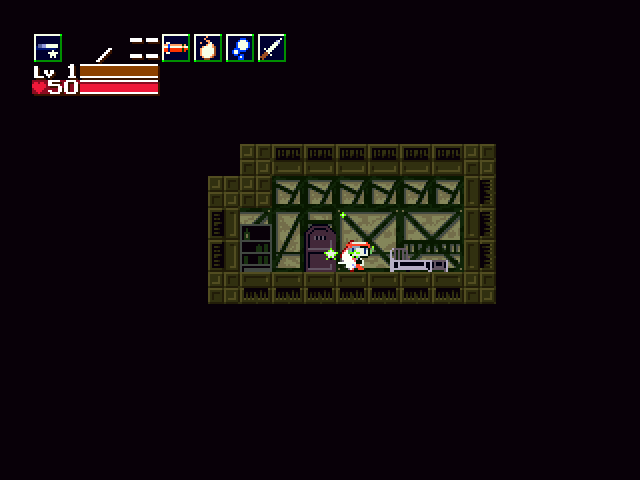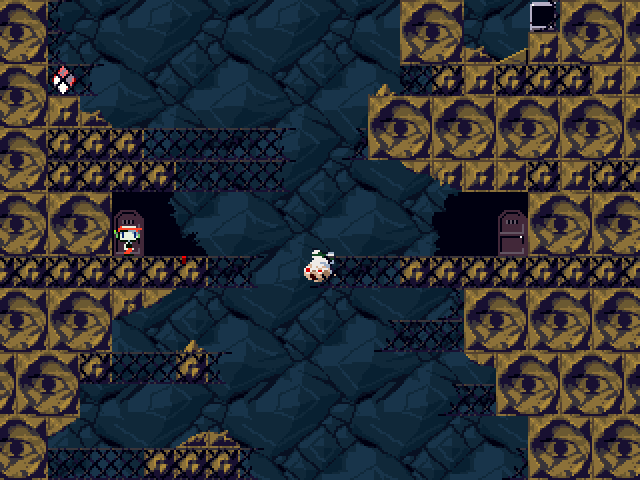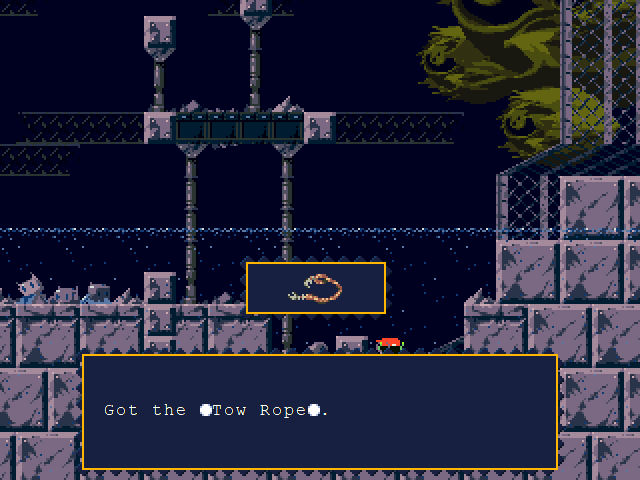Part 1 – Part 2 – Part 3 – Part 4 – Part 5
Part 6 – Part 7 – Part 8 – Part 9
This post continues a series on the intricate design of Cave Story from start to finish. If you’ve missed the previous posts, they’re linked above for your convenience.
The first thing I want to address today is Professor Booster’s memo in the Prefab House. It comes a little late, deliberately so, but it gives a hint towards the best ending if the player wasn’t aware of it already.

This little bit of information—that Professor Booster will upgrade the Booster if he survives—gives the player something to look for, and gives them a reason to play the game again if they missed it.
This is a good time to bring up the details of the aforementioned best ending. The first step the player must take to reach it comes in the Labyrinth: making the jump to avoid getting the Booster v0.8. Unless the player either read the memo at the end of the game or missed Booster falling when they entered the room, it seems like a violation of common sense to avoid helping an old man dropped in a pit. The next step is similar in nature: assuming the player doesn’t have the Booster v0.8, they can pick up the Tow Rope in the room with the Core fight. They can only pick it up before or immediately after the fight; if they’ve already run out of air and received the Air Tank, it won’t be available anymore.
With the Tow Rope, they can pick up Curly in the Core room and carry her with them in the Waterway, where they must stop at a cabin in the midst of the water flow. Until the Nintendo Switch port of Cave Story+, nothing stopped the current from hurtling an unprepared player past the cabin, unable to return without reloading a save file.

Getting to the cabin isn’t enough, however. While in the cabin, the player must sleep in the bed—thereby putting Curly down—check the computer to learn about the notebook on the shelf, read the notebook to learn how to service flooded robots, drain the water from Curly, check her two more times after she wakes up, and say that they don’t want to leave her there.

Taking Curly through the end of the Waterway after draining the water separates her from the player, but she winds up in the Plantation without her memory. In the Plantation, they must talk to the Cthulhu near her, track down the Ma Pignon in the Mimiga Village graveyard (an ordeal in itself), bring it back to her to restore her memory, then talk with her another time to receive the Iron Bond. If the player recovers the Booster v2.0 from Momorin before ascending to the Last Cave, they will then be on track for the best ending.
If I’ve lost you anywhere in that wall of text full of proper nouns, don’t worry. Some of that was deliberate to emphasize this point: while the majority of Cave Story is masterfully designed to guide the player, the steps to reach the best ending are obtuse, leading a majority of players to consult the internet rather than following clues the game itself provides. At best, the player will see Booster’s memo in the Prefab House and pass him by in a subsequent playthrough, which is fine in itself. However, nothing indicates the Tow Rope or the Waterway cabin, both of which are available in a narrow window with no previous indication. It improves afterwards, as the Plantation directs the player toward the alcove where Curly rests and the Ma Pignon is cleverly hinted towards—the only place in the game with mushrooms is the Mimiga Village graveyard. Everything around it is solid and it doesn’t make the game “bad,” but it is an overall blemish on an otherwise exemplary game.
With that out of the way, we return to the Balcony. Before the boss fights, if the player ascends the wall, there’s a secret area with some weapon energy capsules and health. It offers some chance at recovery between the Last Cave and the bosses.

The bed in the house heals the player, but after the Hidden Last Cave, some weapon energy is a much-needed boon. In the same vein, talking to Chaco after the Doctor fight gives the player a chance to heal before the Undead Core. Recovery is a good thing to provide in a boss fight, and the bosses so far have only created enemies that don’t drop anything.
Unlike the previous two examples, there is no healing provided before the return to the Prefab House for the best ending, save full recovery when Sue wakes the player up. This incentivizes making it through the collapse unscathed in order to have the most health available for the trial to come and creates a slight positive feedback loop, like the weapon energy system. A player who can make it back unscathed will have an advantage in the final area over one who gets hit.

The next post will be the last of the series, covering the final challenge between us and the best ending of Cave Story. Join me back here in a couple of weeks for the conclusion!




